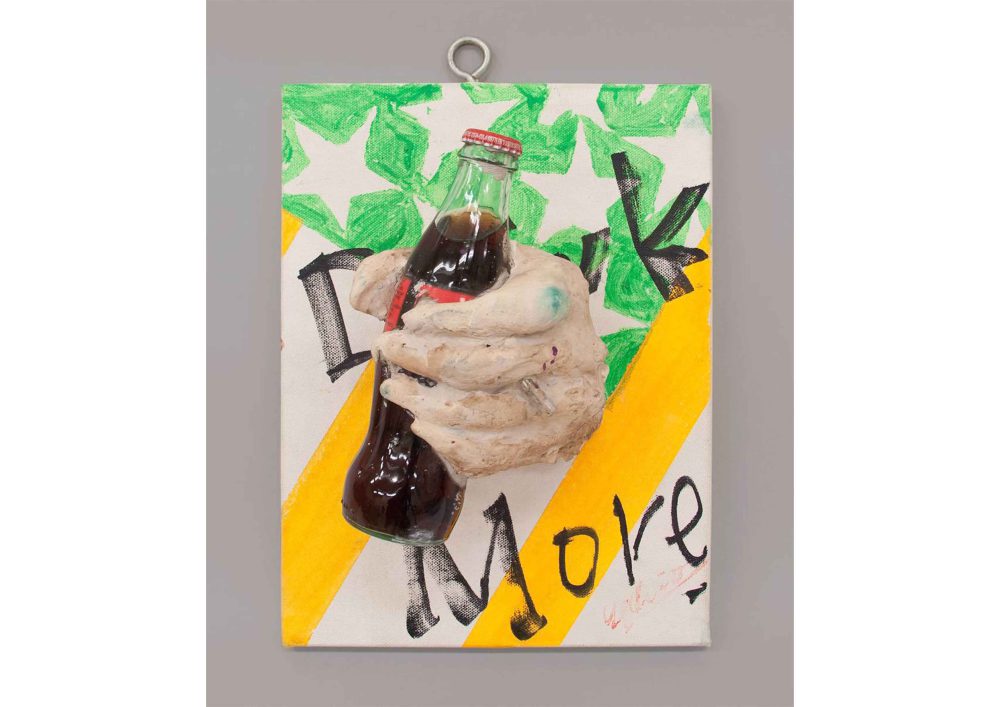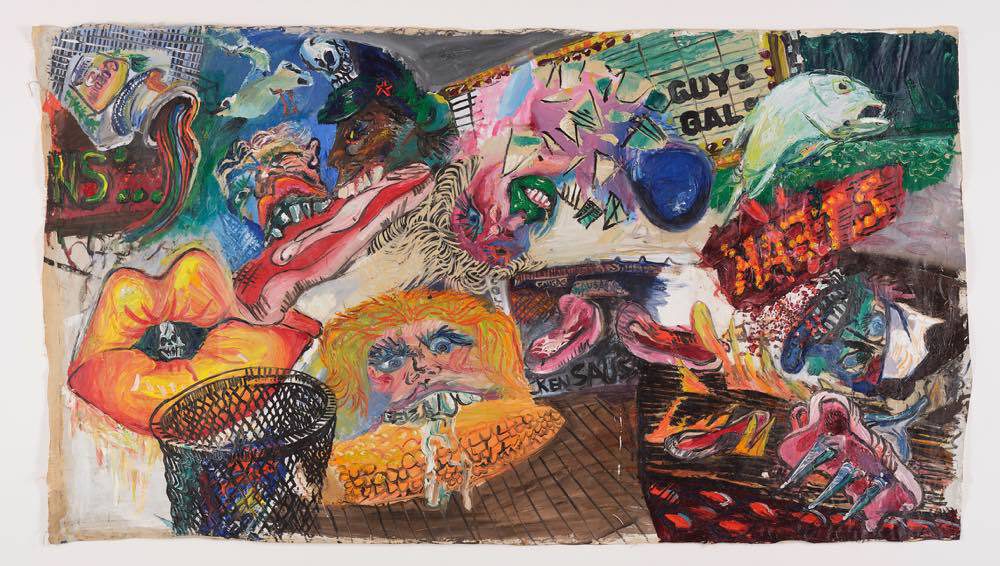
Ushio Shinohara
Solo Exhibition
Blast!!! My Punches on the Aurora!!!
2021.12.4 (Sat) - 2022.1.15 (Sat)
Open on Tue, Wed, Thu, Fri, and Sat. 12:00 – 18:00
*Closed on Sundays, Mondays, and National holidays
*We will be closed for the holiday season from December 26, 2021 to January 10, 2022.
*To protect public health against COVID-19, we will suspend the reception event.

Wild Turkey Running in Snowfield, 2013 ©︎Ushio Shinohara
We at ANOMALY are pleased to announce an upcoming solo exhibition of works by Ushio Shinohara. Titled Blast!!! My Punches on the Aurora!!!, it will run from December 4 (Sat.), 2021 to January 15 (Sat.), 2022.
Born in Tokyo in 1932, Ushio Shinohara participated in the Yomiuri Independent Exhibition beginning in 1955, when he was still a student at the Tokyo National University of Fine Arts and Music. He also showed the work I Don’t Give a Damn Anymore at the 11th installment of this exhibition, in 1959, and his contribution to the 12th in 1960 was dubbed “anti-art” by Yoshiaki Tono along with those of Tetsumi Kudo, and Shusaku Arakawa.*1)In the same year, he formed Neo Dadaism Organizers, a now legendary group that was based in the Shinjuku White House (designed by Arata Isozaki; the current WHITEHOUSE*2))in the Hyakunincho district of Tokyo’s Shinjuku Ward, together with Masunobu Yoshimura, Genpei Akasegawa, Arakawa, and others. The group held a meeting-cum-party every Saturday night, but disbanded after about six months owing to Yoshimura’s marriage and their own recklessness. Nevertheless, their activities went down in the history of avant-garde art in Japan, along with those of Zero Dimension*3)and Hi-Red Center*4), which were formed in 1960 and 1963, respectively, as embodying currents during the period of social upheaval best symbolized by the 1960 demonstrations against the Japan-US Security Treaty.
Shinohara swiftly became the lion of Japan’s art scene with his “action” that stood out for its intense and extraordinary character, as well as his production of attention-getting works. The latter include his Imitation Art series referencing Jasper Johns’s Drink More and Robert Rauschenberg’s Coca-Cola Plan (Shinohara made the acquaintance of these artists when they came to Japan in 1964*5)), and his Oiran series fusing traditional Japanese outlooks with Pop Art expression.

Drink More, 2015 ©︎Ushio Shinohara
Between 1959 and 1961, Shinohara repeatedly experimented with and performed the “boxing painting” that later became one of his signature types of works. At first, he tried dropping a ball of cloth that had been soaked in India ink onto a cloth spread on the ground. He also tried punching not a canvas but old cloth and construction paper while moving from right to left, his fists not clenched in boxing gloves but wrapped in rags soaked with India ink.
He later commented, “If you have the intention of making a good painting, you cannot make one that is truly good. That’s why I quickly throw punches, before my mind can catch up with me.”
Shinohara went to the United States in 1969 after receiving a fellowship from the JDR III Fund. From that year right up to the present, he has maintained his base of activity in New York City, and remains engaged in vigorous production as he nears his 90th birthday. His output includes motorcycles made of cardboard, paintings inspired by popular culture boldly executed in primary colors, boxing paintings, and other works brimming with his wild energy.

Azami (Thistle), 2015 ©︎Ushio Shinohara
This solo exhibition will be Shinohara’s first in Japan in four years. It will show his boxing paintings, vividly colored paintings taking popular culture as their theme that he produced in the 1970s and 1980s (mainly in New York) and were found in his studio in recent years, and huge paintings from his Oiran series.
As he mentions in his correspondence with Keiichi Tanaami, Shinohara receives great inspiration on an almost daily basis from living in New York, where he initially moved by himself, and the art works and scene there. While confronting the dynamism of the consumer society head-on, he produced various 3D works using cardboard and other scrap material, and paintings that are graphically raw depictions of the lives of the masses, along with his “action” performances. The exhibition will enable visitors to retrace his entire career.

Hungry City, Times Square, 1974 ©︎Ushio Shinohara
Grounded in the watchwords “quickly, beautifully, and rhythmically,” Shinohara’s “boxing paintings” achieved their first revival since 1961 in 1991, at the opening performance of the exhibition Japanese Anti-Art: Now and Then at the National Museum of Art, Osaka.
Beginning in the 1990s, there was a growing movement for re-appreciation of Shinohara’s work. At the exhibition Japanese Art After 1945: Scream Against the Sky held at the Yokohama Museum of Art in 1994 curated by Alexandra Monroe, he again showed Drink More (1964) and was acclaimed as one of the leaders of trends in postwar Japanese art. He went on to show works at the exhibition Japanese Summer 1960 – 1964 (I don’t give a damn anymore!) held at Art Tower Mito in 1997, and the Neo Dada Japan, 1958 – 1998: Arata Isozaki and the White House Crowd+ exhibition at Art Plaza Oita in 1998.
These were followed by the exhibition Gyu and Chu (referring to Shinohara and Chu Enoki) at the Toyota Municipal Museum of Art in 2007 and the release of a documentary film titled Cutie and the Boxer on his everyday struggles with his wife Noriko, who is also an artist, in 2013. This film was nominated for an Oscar in the 86th Academy Awards and created quite a stir.

Oiran, 1969/2014 ©︎Ushio Shinohara
Shinohara participated in the International Pop exhibition that toured the States (it was held at the Dallas Museum of Art, Walker Art Center, and Philadelphia Museum of Art)*6) in 2015 and The World Goes Pop exhibition*7) that went on tour after being held in the same year at Tate Modern. At the latter exhibition, his Oiran series was used as the main image. His works were also shown at the Gyu-chan, 60 Years of Roaring on the Avant-Garde Road exhibition held at the Kariya City Art Museum in 2017 and the 1968: Art in the Turbulent Age exhibition held at the Kitakyushu Municipal Museum of Art, Chiba City Museum of Art, Shizuoka Prefectural Museum of Art, and The Museum of Art, Kochi in 2018. He held a solo exhibition titled Shinohara Pops!*8)at the Samuel Dorsky Museum of Art, and participated in the Parody and Intertextuality: Visual Culture in Japan Around the 1970s exhibition at Tokyo Station Gallery, both in 2019.
At present, Shinohara’s works are being shown at the Stop Painting exhibition that is sponsored by the Fondazione Prada and curated by Peter Fischli*9)and the Jasper Johns: Mind/Mirror exhibition at the Philadelphia Museum of Art.*10)In short, his art has been enthusiastically applauded both inside and outside Japan.
Shinohara continues to roar down the “avant-garde road” with a mind that remains as incisive and high-rpm as it was in his youth, and his “boxing paintings” whose punches are too fast even for it. This exhibition celebrates his return to Japan, and we would be grateful for your cooperation with publicity for it.

Ushio Shinohara, photo by James Ware Billett
Notes:
*1)
-“The Morphology of Vengeance: Yomiuri Independent Exhibition and Social Protest in the 1960s,” Avant-Garde Art in Postwar Japan+, Yokohama Museum of Art, The Yomiuri Shimbun, 1994, p.68
– Chinori Cho, “artscape Artworlds – Anti-Art” (last viewing date: November 19, 2021)
*2)A passport-based art space opened in 2021. It is operated under the direction of Ryuta Ushiro of Chim↑Pom, the artist Tomohito Wakui, and Nao Nakamura of the gallery naonakamura.
*3)Tomomi Kurisu (last viewing date: November 19, 2021)
– An avant-garde art group formed by Yoshihiro Kato and Shinichi Iwata in Nagoya around the concept of reducing human actions to zero.
*4)An avant-garde art group formed in 1963 with three members: Jiro Takamatsu, Genpei Akasegawa, and Natsuyuki Nakanishi.
*5)
-Akiko Hyuga, “Ushio Shinohara and Action Theory,” Ushio Shinohara Exhibition Catalogue+, Hiroshima City Museum of Contemporary Art, Mainichi Shimbun, 1992, p.9
– Ushio Shinohara vs Naohiro Ukawa, Dialogues with Ushio Shinohara – Swiftly, Beautifully, and Rhythmically+, Bijutsu Shuppan-sha Co., Ltd., 2006, p.191
*6) Samuel Dorsky Museum of Art.“SHINOHARA POPS! THE AVANT-GARDE ROAD, TOKYO/NYC”.
*7)DALLAS MUSEUM OF ART. “International Pop”.
[https://dma.org/art/exhibitions/international-pop]
*8) TATE.“THE WORLD GOES POP”.
[https://www.tate.org.uk/whats-on/tate-modern/exhibition/world-goes-pop]
*9)SFondazione Prada.“STOP PAINTING – AN EXHIBITION BY PETER FISCHLI”.
[https://www.fondazioneprada.org/project/stop-painting/?lang=en]
[https://www.newpaltz.edu/museum/exhibitions/shinohara.html]
*10)Philadelphia Museum of Art.“Jasper Johns: Mind/Mirror”.
[https://philamuseum.org/calendar/exhibition/jasper-johns-mindmirror]
Bibliography:
– Ushio Shinohara Exhibition Catalogue+, Hiroshima City Museum of Contemporary Art, Mainichi Shimbun, 1992
– Avant-Garde Art in Postwar Japan+, Yokohama Museum of Art, The Yomiuri Shimbun, 1994
– Ushio Shinohara – Boxing Paintings and Motorcycle Sculptures, The Museum of Modern Art, Kamakura & Hayama, 2005
– Dialogues with Ushio Shinohara – Quickly, Beautifully, and Rhythmically+, Bijutsu Shuppan-sha Co., Ltd., 2006
– Ushio Shinohara Exhibition: Gyu-chan, 60 Years of Roaring on the Avant-garde Road, Kariya City Art Museum, 2017
– Ushio Shinohara, editing by Keiichi Tanaami, From Ushio Shinohara to Keiichi Tanaami, 50 Years of Correspondence+, Tokyo Kirara, 2021
– Oral History Archives of Japanese Art, Ushio Shinohara Oral History+, February 13, 2009
[http://www.oralarthistory.org/archives/shinohara_ushio/interview_01.php]
*Titles marked with a plus sign (+) are tentative translations.
Ushio Shinohara
Born in Tokyo, 1932. Lives and works in New York, USA.
During his time studying at Tokyo University of the Arts majoring in Yōga (western-style painting), Shinohara apprenticed to Takeshi Hayashi, and participated in the Yomiuri Independent Exhibition, which made his rise to stardom. After leaving the university, Shinohara established the group “Neo Dada Organizers” with Masanobu Yoshimura in 1960. Despite a short time period of activity as a group, their phenomenal and radical performances have brought significant impact upon Japanese art scene. In 1969, he received a fellowship from The JDR 3rd Fund to spend a year in the United States. Ever since, his large-scale paintings from a vibrant color palette and Shinohara’s energetic “Boxing-Painting” attracted significant attention nationally and internationally. In 2007, he received the 48th Mainichi Art Award for his long-standing achievement. Ushio and his wife Noriko Shinohara debuted in a film “Cutie and the Boxer” directed by Zachary Heinzerling, and it was nominated in 2014 for the Academy Award for Best Documentary Feature at the 86th Academy Awards. In 2015, he participated in the exhibition “International Pop” organized by and toured from Walker Art Center, Dallas Museum of Art, and the Philadelphia Museum of Art through 2016, followed by the exhibition “The World Goes Pop” at Tate Modern in the same year. After 10 years, he returned to Japan with his solo exhibition presented at YAMAMOTO GENDAI in Tokyo, featuring a signature boxing performance/painting at the opening. Shinohara still remains as one of the respected artists representing Japan.
As one of the outstanding artists living today to represent the country, his energetic presence is everlasting with more recent solo exhibitions including “Shinohara Pops! The Avant-Garde Road, Tokyo/New York” The Samuel Dorsky Museum of Art, NY (2012) and “Gyu-chan, 60 years of roaring on the avant-garde road” Kariya City Art Museum, Aichi (2017) along with the group exhibitions “Parody, around 1970s right and left of double voice – – Japan” Tokyo Station Gallery (2017) and “1968: Art in the Turbulent Age” Kitakyushu Municipal Museum of Art, Chiba City Museum of Art, Shizuoka Prefectural Museum of Art, The Museum of Art, Kochi (2018).
Collection
MoMA, New York, US
Musee d’art contemporain de Montreal, Canada
Musée d’art Contemporain, Lyon, France
National Gallery Prague, Czech Republic
Museum of Contemporary Art, Tokyo, Japan
Hara Museum of Contemporary Art, Tokyo, Japan
Itabashi Art Museum, Tokyo, Japan
The National Museum of Art, Osaka, Japan
etc.
















































